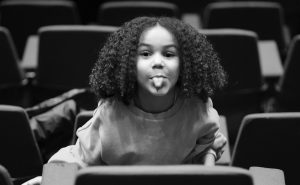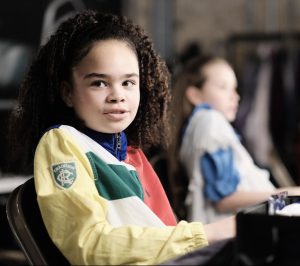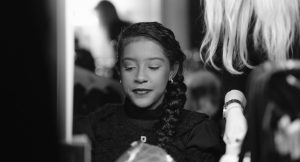
It’s super important to film a good self-tape and make a good first impression!
For most acting jobs, the first-round audition is done in the form of a self-tape. You film this at home and we send it into the casting team so that they can shortlist their favourites and invite them into an in-person audition or casting. So, it is super important that you film a good self-tape and make a good first impression!
You usually start with an ident (also known as a slate or introduction). This is where you introduce yourself and say your name, age, height (in cm), where you are based, and your agency. They also sometimes ask to see profiles and hands. For this, make sure your hair (if long) is behind your ears. Turn both feet to face one side, then the other side to your right and left profiles. Then hold your hands up to camera and show the front and back (a couple of seconds each side!).
Sometimes the casting team send a script for you to tape, other times they send a scenario and sometimes they just want you to chat to camera.
 As a general rule of thumb… speak directly to camera for idents and general chats.
As a general rule of thumb… speak directly to camera for idents and general chats.
If you are asked to do a script or scenario, avoid looking directly to camera. You should imagine whoever you are talking to is either to the right or left of the camera (but close to it!). Remember to make sure that this person doesn’t move around during the scene (keep your attention to the same point!). If you speak to more than one person in the scene you are taping, you might want to imagine that one of them is the other side of the camera, so you know exactly who to speak to!
Sometimes, you will be asked to record some singing in a self-tape (if auditioning for a musical), and they will normally send you backing tracks and sheet music to sing along to. When taping, make sure you play the music through a speaker if possible (not directly from a phone or laptop). Place the speaker away from the phone / recording device, otherwise it will be too loud.
Do a few takes so you can go back through them and pick the best ones.
Remember, acting for TV/film is more subtle than acting for a stage. It should be more focussed and still. For theatre, actions can be bigger! For both, plant your feet, speak slowly and with confidence and do a few takes so you can go back through them and pick the best ones.
Self-tapes can be tough, especially after a long day at school and activities. But remember, everyone has to do them, so you are not on your own. This is your chance to show the casting director what you can do so really go for it and leave them wanting more. If they want it done another way / sightly differently, they will ask or bring you in for a recall! You never know what your tape might lead to!
General Taping Rules

1. Shoot Horizontally (LANDSCAPE)
Your audition tape should always be shot horizontally (unless specified otherwise). If the casting director requests a full-body slate/shot, place your camera far enough away to get your entire body in frame. If you don’t have enough space to do so, make sure you pan the camera down to your feet.
2. Stay in Frame
You should always film in a medium close-up… head and shoulders only. Don’t cut off the top of your head in the shot or leave too much empty space above you. Be careful not to move around too much during your scene and accidentally step out of focus or out of frame.
Your camera should be placed at eye level. If you are reading a script, working with someone to read the other lines, have them stand directly to the left or right of the camera so you can actually speak to them. Except when you slate, you should never be looking directly into the camera. If your scene partner is reading for multiple characters, set your eye line at a slightly different place for each one, the way you would look between multiple actors on set.
3. Keep Your Background Clear
You should always film in front of a blank, neutral background. A plain wall in white, grey, blue, or another neutral colour works perfectly. There should be no furniture or objects – and no clutter visible behind you. The aim is to keep your audition looking clean and professional and to avoid drawing focus away from you!
If you don’t have a blank wall available or live in a tight space, backdrops kits are available in various colours and are easy to collapse and store away. When buying a kit, keep in mind your complexion, hair, and the colours you usually wear to choose a backdrop colour that will make you stand out.
 4. Shoot in good lighting
4. Shoot in good lighting
If you’re recording in natural light, try to position yourself with the window in front of you to avoid back lighting or shadows across your face. Use a ring light if you have one! To avoid distracting background noises such as loud traffic or a barking dog.
5. Know Your Lines
As with any audition, you should always learn the lines off by heart! Remember, the good thing about a self-tape is that you can always record another take if you forget a line.
If an audition comes in at the last minute and you need the script in hand, make sure to hold the papers as still as possible (rustling sounds or the paper popping up into frame can be very distracting), and hold it up at eye level so you aren’t looking down. Even better if you can pop then next to the camera at eye level so it looks like you are really speaking to someone!
 6. What to wear
6. What to wear
Choose clothing that is flattering and will make your hair and skin stand out again your background. If you are particularly fair, for example, and taping against a white wall, a white top may not be the best choice. Avoid tops with logos, graphics, or bold patterns – solid colours work best.
Avoid wearing distracting jewellery, hats, accessories, or lots of makeup. The focus of the tape should always be on you and your performance, not your outfit.
8. Remember the Medium
Acting for film & television is really different than acting for theatre. In the theatre, actors must project to be heard from the back of the theatre, but on screen, the camera picks up the smallest movement so subtlety is key.
9. Submit a Single Video
After you’re happy with your takes, be sure to edit all your clips together (unless your agent has asked for them separately!). In addition to your ident, you may be asked to prepare more than one scene.
iMovie or CapCut are the easiest editing softwares to use!
 10. Practice, Practice, Practice
10. Practice, Practice, Practice
Take your time with self-tapes – try not to rush them! The more you do, the quicker and easier they will get. Once you have the knack with the lighting and set up you’ll be a pro! Enjoy taping – a self-tape could land you your dream role!
